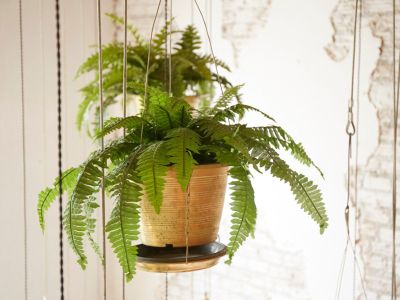Tips for Growing Ferns Indoors
There are a lot of species of tropical and subtropical ferns, but there are also a lot of ferns that are native to more temperate climates. These ferns would be well suited to cooler parts of the house but won’t survive in rooms that are too well heated. Tropical ferns survive best in homes with central heating. Below are recommend indoor conditions for optimal fern growth:
Humidity
All ferns love moisture and should be given humid conditions. In living rooms and family rooms, stand their pots on trays of damp pebbles or clay granules. Ferns also love being misted at regular intervals with tepid, soft water unless the humidity of the whole room is kept high through the use of a humidifier.
Compost/Soil
You also need to provide the right compost. Most ferns are forest or woodland plants and have tender, delicate roots adapted to the light forest soil, which is rich in leaf mold and decayed vegetable matter. The right compost must be free draining so that the roots never get waterlogged. A compost that contains peat or a fibrous peat substitute with plenty of sand is best. The compost should never be allowed to dry out, which may mean watering the plant a little every single day in a warm, dry atmosphere.
Light
Although most ferns grow in moist, shady places like forest floors, this does not mean that they need no light. Their normal situation in the wild is dappled light, and if the light level in the home is too low, you will see poor growth and yellowing fronds. Give your ferns a position near a window that gets morning or late afternoon sun, and keep the ferns away from strong sunlight, especially during the summer. Direct sunlight will make them lose their leaves or turn their fronds yellow. You can keep your ferns in dim light as long as you give them regular breaks in bright light. They can be given artificial light, but this should be from a special gardening bulb or a fluorescent strip. Ordinary light bulbs generate too much heat.
Temperature
An individual fern’s place of origin and adaptability will determine how high or low of a temperature the fern needs. Most ferns don’t like cold. Those ferns from tropical regions truly appreciate 60-70 F (15-21 C.). Those from more temperate regions enjoy temperatures between 50-60 F. (10-16 C).
Fertilizer
Feed your ferns in the summertime every two to four weeks with a liquid fertilizer, but don’t mix it full strength because you can damage the root system. Just a few drops of fertilizer can be added to the water occasionally for misting. Don’t feed your ferns in the winter because they rest. In order to keep the air around your ferns moist, mist them often.
Repotting
You can repot your ferns in the springtime, but only if their roots are filling the pot. Otherwise, just scrape off the top layer of compost and replace it with fresh compost. Cut off any damaged fronds to encourage new growth. When you repot your ferns, split them up and make two out of one. You can also grow new ferns from the powdery spores produced in little capsules. These capsules are visible as rows of rusty, brown patches on the underside of the fronds. These will grow into a green film into which the fern will grow.
Indoor Fern Companions
Bromeliads are plants similar to the pineapple with a rosette of firm, fleshy leaves. Some have a larger piece in the center or have plants with less form that wander without roots in the pot. The roots of a bromeliad are used simply for anchoring it to a support. They are not used for gathering nourishment. They make striking potted plants and also adapt well to hanging baskets. There are also tillandsias. These grow well in pots and are great for hanging baskets because they have arching foliage and take their nourishment directly from their environment or air. They require very little water. Keep in mind that bromeliads are tropical; they require warmer temperatures of 60-70 F. (15-21 C.) and some moisture. However, the tillandsias don’t require near as much moisture and you can actually grow them in shells, rocks, and such. Ferns, tillandsias, and bromeliads are just as easy to grow as the palms, but be sure to pay attention to each of their needs.
